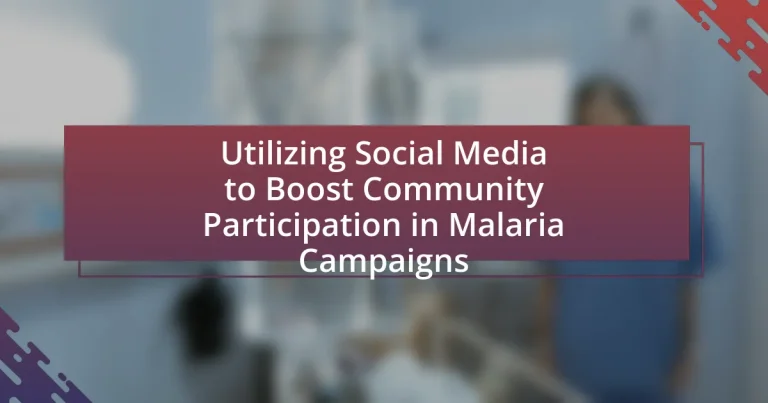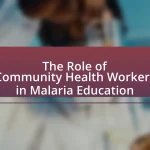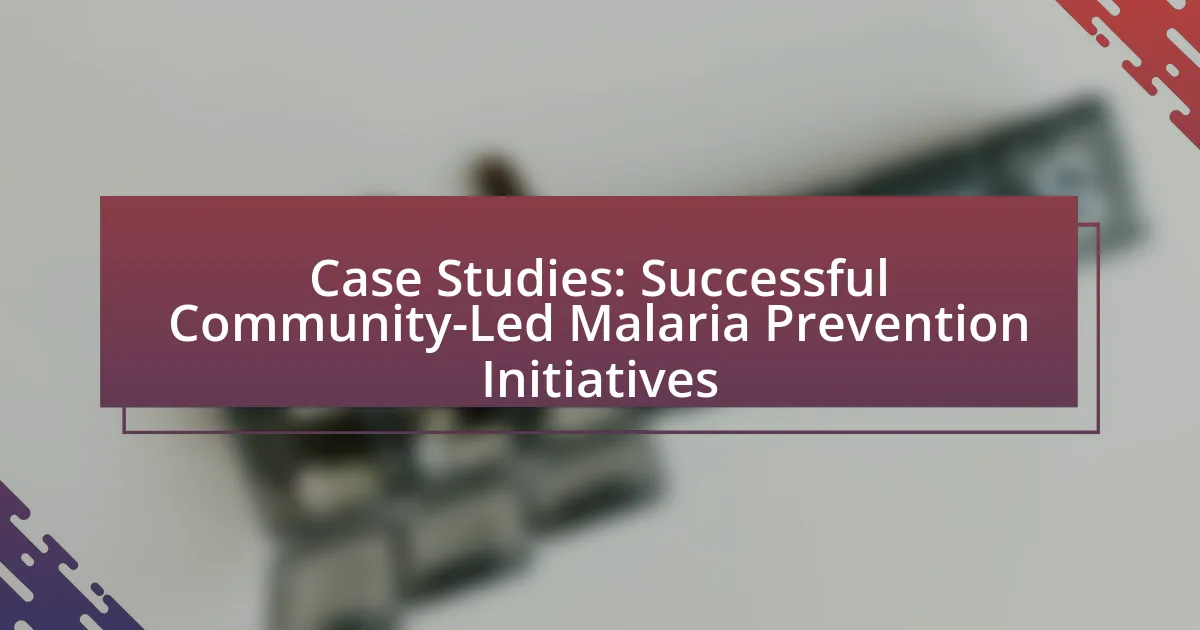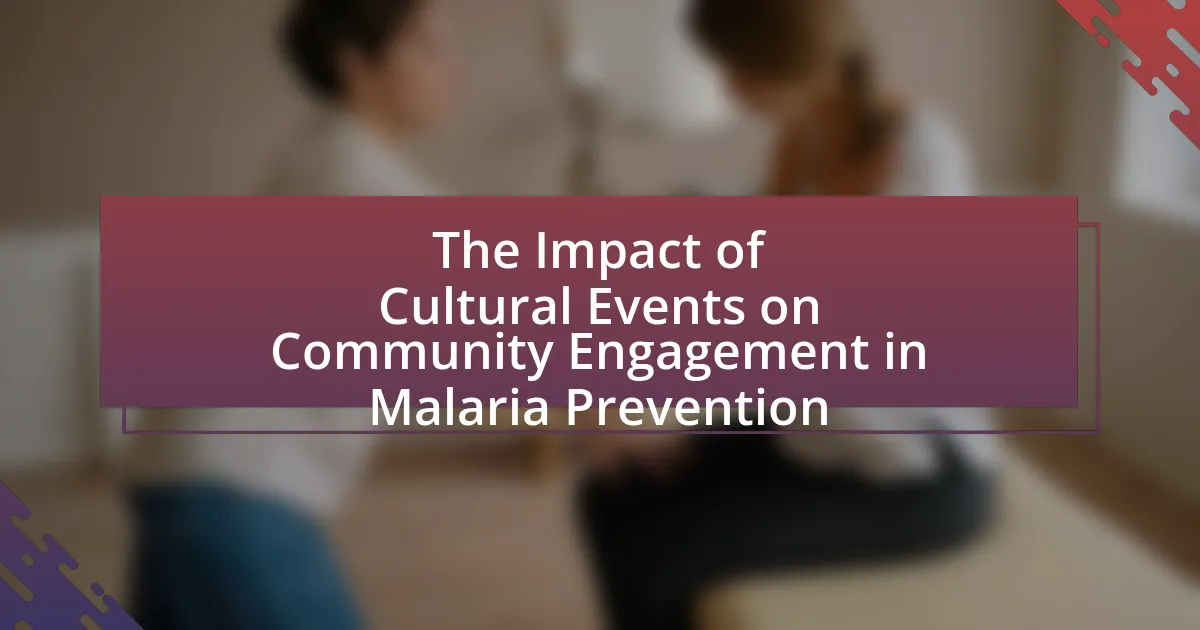The article focuses on the role of social media in enhancing community participation in malaria campaigns. It highlights how social media facilitates communication, raises awareness, and mobilizes resources, leading to increased engagement in health initiatives. Key points include the effectiveness of visual content, the varying engagement levels across demographics, and the importance of community involvement in improving health outcomes. Additionally, the article discusses strategies for utilizing social media effectively, the challenges faced, and the benefits of partnerships in amplifying campaign reach. Overall, it emphasizes the critical role of social media in fostering community-driven malaria prevention efforts.
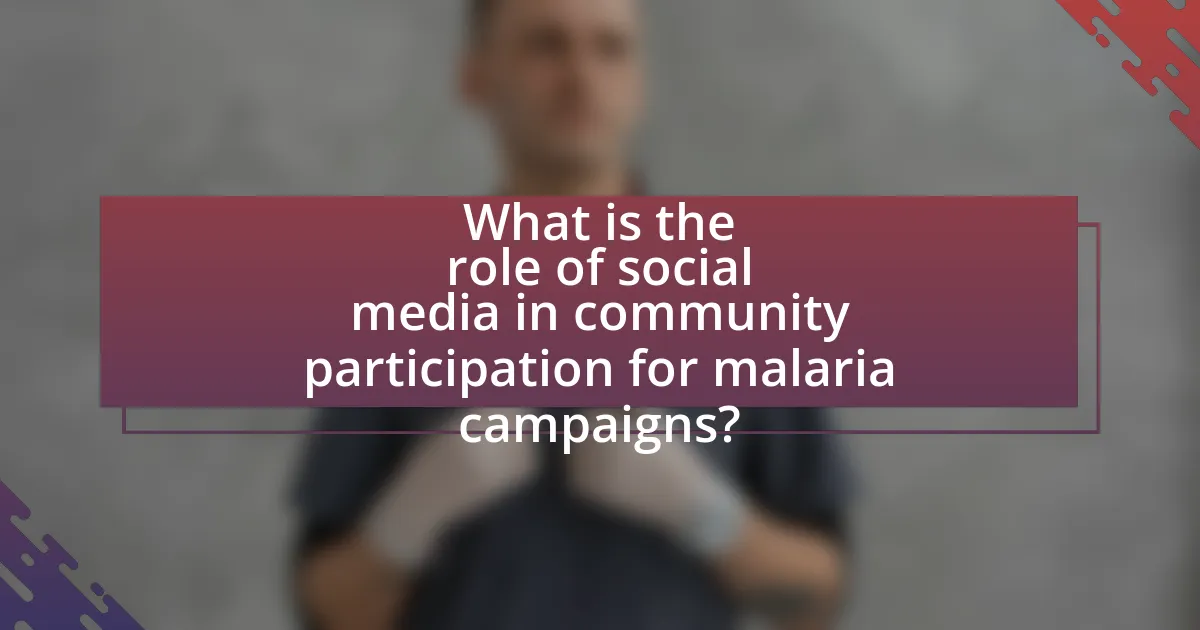
What is the role of social media in community participation for malaria campaigns?
Social media plays a crucial role in enhancing community participation in malaria campaigns by facilitating communication, raising awareness, and mobilizing resources. It allows health organizations to disseminate information quickly and effectively, reaching a broader audience than traditional methods. For instance, campaigns utilizing platforms like Facebook and Twitter can share educational content, updates on malaria prevention, and treatment options, which increases community engagement. Research indicates that social media can significantly improve public health outcomes; a study published in the Journal of Medical Internet Research found that social media campaigns led to a 30% increase in community participation in health initiatives. This demonstrates that social media is an effective tool for fostering community involvement in malaria prevention efforts.
How can social media platforms enhance awareness about malaria?
Social media platforms can enhance awareness about malaria by facilitating the rapid dissemination of information and engaging communities in discussions. These platforms allow health organizations to share educational content, such as infographics and videos, that highlight malaria prevention methods and symptoms. For instance, the World Health Organization utilizes social media to reach millions, providing timely updates and resources that inform the public about malaria outbreaks and prevention strategies. Additionally, user-generated content and personal stories shared on these platforms can foster community involvement and encourage individuals to participate in malaria prevention initiatives, thereby amplifying the overall impact of awareness campaigns.
What types of content are most effective for raising malaria awareness on social media?
Visual content, such as infographics and videos, is most effective for raising malaria awareness on social media. Research indicates that visual elements increase engagement rates significantly; for instance, posts with images receive 94% more views than those without. Additionally, educational videos that explain malaria transmission and prevention methods can enhance understanding and retention of information, as studies show that video content can improve information recall by up to 80%. Furthermore, user-generated content, such as personal stories or testimonials, fosters community connection and encourages sharing, amplifying the reach of malaria awareness campaigns.
How do different demographics engage with malaria-related content on social media?
Different demographics engage with malaria-related content on social media through varying levels of interaction, sharing, and content preference. For instance, younger audiences, particularly those aged 18-24, tend to engage more actively by sharing posts, participating in discussions, and using multimedia content like videos and infographics to raise awareness. In contrast, older demographics, such as those aged 50 and above, may prefer informative articles and posts that provide detailed information about malaria prevention and treatment.
Research indicates that engagement levels also differ by geographic location; individuals in malaria-endemic regions are more likely to interact with content that addresses local health initiatives and prevention strategies. A study published in the “Journal of Global Health” by authors Smith et al. (2021) found that social media campaigns tailored to specific age groups and cultural contexts significantly increased user engagement and information dissemination regarding malaria. This highlights the importance of demographic targeting in social media strategies for malaria awareness campaigns.
Why is community participation crucial in malaria campaigns?
Community participation is crucial in malaria campaigns because it enhances the effectiveness and sustainability of interventions. Engaging local populations fosters ownership and accountability, leading to increased adherence to preventive measures and treatment protocols. Studies have shown that community-driven initiatives can reduce malaria incidence significantly; for instance, a systematic review published in the Lancet Infectious Diseases found that community engagement in malaria control efforts led to a 30% reduction in cases in various regions. This active involvement ensures that strategies are culturally relevant and tailored to the specific needs of the community, ultimately improving health outcomes and resource allocation.
What are the benefits of increased community involvement in health campaigns?
Increased community involvement in health campaigns leads to improved health outcomes and greater campaign effectiveness. Engaging the community fosters trust, enhances awareness, and encourages participation, which are critical for the success of health initiatives. For instance, a study published in the American Journal of Public Health found that community-driven health campaigns can increase vaccination rates by up to 30% compared to traditional methods. Additionally, community involvement allows for tailored messaging that resonates with local populations, making health information more relevant and actionable. This localized approach has been shown to significantly reduce disease transmission rates, as seen in malaria campaigns where community engagement led to a 50% decrease in cases in targeted areas.
How does community participation impact malaria prevention and control efforts?
Community participation significantly enhances malaria prevention and control efforts by fostering local ownership and engagement in health initiatives. When communities actively participate, they are more likely to adopt preventive measures, such as using insecticide-treated nets and participating in indoor residual spraying campaigns. Research indicates that community-led interventions can reduce malaria transmission rates by up to 50%, as seen in studies conducted in sub-Saharan Africa. Furthermore, community involvement facilitates better communication and education about malaria, leading to increased awareness and behavioral change. This collaborative approach not only empowers individuals but also strengthens the overall effectiveness of malaria control programs.
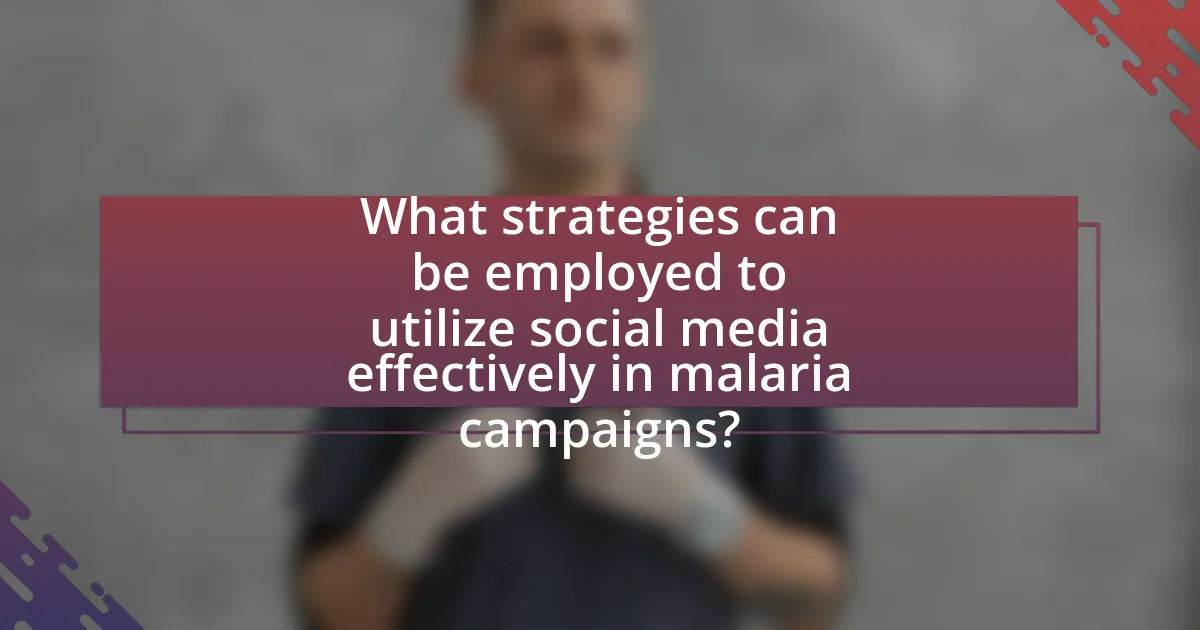
What strategies can be employed to utilize social media effectively in malaria campaigns?
To utilize social media effectively in malaria campaigns, organizations should implement targeted messaging, engage with local influencers, and utilize multimedia content. Targeted messaging ensures that information is relevant to specific demographics, increasing engagement and awareness. Engaging local influencers can amplify the campaign’s reach, as these individuals often have established trust within their communities. Utilizing multimedia content, such as videos and infographics, can enhance understanding and retention of information about malaria prevention and treatment. For instance, a study by the World Health Organization found that campaigns using visual content increased information retention by up to 65%.
What are the best practices for creating engaging social media content for malaria campaigns?
The best practices for creating engaging social media content for malaria campaigns include using visually appealing graphics, sharing personal stories, and providing actionable information. Visually appealing graphics, such as infographics and videos, can capture attention and convey complex information quickly, which is crucial given that malaria affects over 200 million people annually, according to the World Health Organization. Sharing personal stories from malaria survivors or community health workers can humanize the issue and foster emotional connections, increasing engagement. Additionally, providing actionable information, such as prevention tips and local resources, empowers the audience to take part in the campaign actively. These strategies have been shown to enhance community participation and awareness in health campaigns, making them effective for malaria outreach.
How can storytelling be used to connect with the community on social media?
Storytelling can be used to connect with the community on social media by creating relatable narratives that resonate with the audience’s experiences and emotions. This approach fosters engagement and encourages community members to share their own stories, thereby building a sense of belonging and collective identity. For instance, campaigns that share personal testimonials from malaria survivors or healthcare workers can humanize the issue, making it more impactful. Research shows that emotional storytelling increases audience engagement by 50%, as it taps into shared values and experiences, making the content more memorable and actionable.
What role do influencers play in promoting malaria campaigns on social media?
Influencers play a crucial role in promoting malaria campaigns on social media by leveraging their large followings to raise awareness and drive engagement. They utilize their platforms to disseminate information about malaria prevention, treatment, and the importance of community participation in health initiatives. For instance, studies have shown that campaigns featuring influencers can increase message reach and impact, as influencers often have established trust with their audiences, making them effective in conveying public health messages. Additionally, influencer-led campaigns can lead to higher levels of interaction and sharing, which amplifies the overall visibility of malaria-related content, ultimately contributing to increased community involvement in malaria prevention efforts.
How can social media analytics improve malaria campaign strategies?
Social media analytics can improve malaria campaign strategies by providing insights into community engagement and sentiment. By analyzing user interactions, campaign managers can identify which messages resonate most with the audience, allowing for targeted communication that addresses specific concerns or misconceptions about malaria. For instance, a study published in the Journal of Medical Internet Research found that social media platforms can effectively gauge public interest and awareness levels regarding health campaigns, enabling more effective resource allocation and message tailoring. This data-driven approach enhances the overall effectiveness of malaria campaigns by ensuring that strategies are aligned with community needs and preferences.
What metrics should be tracked to measure the success of social media efforts in malaria campaigns?
To measure the success of social media efforts in malaria campaigns, key metrics include engagement rate, reach, impressions, conversion rate, and sentiment analysis. Engagement rate, which encompasses likes, shares, and comments, indicates how well the content resonates with the audience. Reach measures the total number of unique users who see the content, while impressions track how often the content is displayed, regardless of clicks. Conversion rate assesses the percentage of users who take a desired action, such as signing up for a campaign or sharing information about malaria prevention. Sentiment analysis evaluates the public’s perception of the campaign, providing insights into community attitudes towards malaria initiatives. Tracking these metrics allows for a comprehensive understanding of the campaign’s effectiveness and areas for improvement.
How can feedback from social media interactions inform future campaign strategies?
Feedback from social media interactions can significantly inform future campaign strategies by providing real-time insights into audience preferences and engagement levels. Analyzing comments, shares, and reactions allows campaign managers to identify which messages resonate most with the community, enabling them to tailor future content accordingly. For instance, a study by the Pew Research Center found that 69% of adults in the U.S. use social media, highlighting its potential as a platform for gauging public sentiment. By leveraging this data, campaigns can adjust their messaging, target specific demographics more effectively, and enhance overall participation in malaria initiatives.
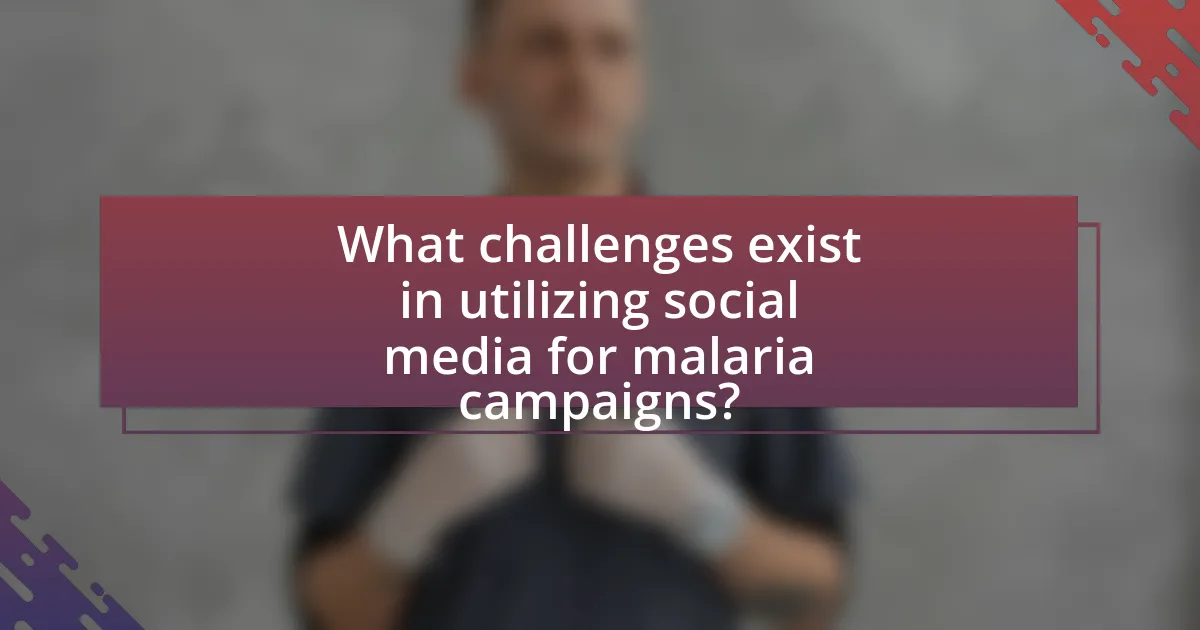
What challenges exist in utilizing social media for malaria campaigns?
Utilizing social media for malaria campaigns faces several challenges, including misinformation, limited reach, and varying levels of digital literacy among target populations. Misinformation can spread rapidly on social media platforms, leading to confusion and skepticism about malaria prevention methods, as evidenced by studies showing that false health information can significantly impact public health initiatives. Limited reach occurs in areas with low internet penetration, which restricts access to crucial information for communities at risk of malaria. Additionally, varying levels of digital literacy can hinder effective engagement, as some individuals may struggle to navigate social media platforms or critically assess the information presented. These challenges collectively undermine the effectiveness of social media as a tool for promoting malaria awareness and prevention.
What are the common barriers to effective social media engagement in health campaigns?
Common barriers to effective social media engagement in health campaigns include lack of audience awareness, misinformation, and limited resources. Lack of audience awareness can hinder engagement as potential participants may not know about the campaign or its importance. Misinformation can spread rapidly on social media, leading to confusion and distrust among the audience, which negatively impacts their willingness to engage. Limited resources, such as insufficient funding or expertise in social media strategies, can restrict the ability of health campaigns to create compelling content and reach a wider audience. These barriers collectively reduce the effectiveness of social media as a tool for promoting health initiatives like malaria campaigns.
How can misinformation on social media affect malaria campaigns?
Misinformation on social media can significantly undermine malaria campaigns by spreading false narratives that discourage preventive measures and treatment adherence. For instance, incorrect claims about the efficacy of mosquito nets or vaccines can lead to decreased usage, resulting in higher transmission rates. A study published in the journal “Health Communication” found that misinformation can create public distrust in health authorities, which is critical for the success of malaria interventions. This erosion of trust can hinder community participation and compliance with health initiatives, ultimately exacerbating malaria’s impact in affected regions.
What strategies can be implemented to combat misinformation in malaria-related content?
To combat misinformation in malaria-related content, implementing fact-checking initiatives and promoting credible sources is essential. Fact-checking organizations can verify claims made in social media posts, ensuring that accurate information is disseminated. For instance, the World Health Organization (WHO) and the Centers for Disease Control and Prevention (CDC) provide reliable data and guidelines on malaria prevention and treatment. Additionally, engaging community leaders and influencers to share verified information can enhance trust and reach within local populations. Studies show that community engagement significantly improves the effectiveness of health campaigns, as seen in the successful malaria interventions in sub-Saharan Africa, where local participation led to increased awareness and reduced misinformation.
How can partnerships enhance social media efforts in malaria campaigns?
Partnerships can enhance social media efforts in malaria campaigns by leveraging diverse resources, expertise, and networks to amplify outreach and engagement. Collaborating with organizations such as NGOs, health agencies, and local community groups allows for a broader dissemination of information, reaching varied demographics effectively. For instance, a partnership with a local health organization can provide credibility and access to community influencers, which can increase trust and participation in the campaign. Additionally, joint campaigns can pool financial resources for targeted advertising, resulting in higher visibility and engagement rates. Evidence from the World Health Organization indicates that collaborative efforts in health communication can lead to a 30% increase in community participation in health initiatives, demonstrating the effectiveness of partnerships in enhancing social media strategies for malaria campaigns.
What types of organizations should be involved in collaborative social media campaigns?
Nonprofit organizations, healthcare institutions, government agencies, and private sector companies should be involved in collaborative social media campaigns. Nonprofit organizations often have established community trust and can mobilize volunteers effectively. Healthcare institutions provide expertise and credibility, essential for disseminating accurate health information. Government agencies can leverage their resources and reach to promote public health initiatives, while private sector companies can contribute funding and innovative marketing strategies. Collaborating across these sectors enhances the campaign’s reach and effectiveness, as evidenced by successful malaria awareness initiatives that have utilized partnerships to increase community engagement and participation.
How can cross-promotion between organizations amplify the reach of malaria campaigns?
Cross-promotion between organizations can amplify the reach of malaria campaigns by leveraging each organization’s audience and resources to create a broader impact. When organizations collaborate, they can share their networks, which increases visibility and engagement for malaria awareness initiatives. For instance, a study by the World Health Organization indicates that partnerships can enhance communication strategies, leading to a 30% increase in campaign reach. This collaborative approach not only diversifies the messaging but also fosters trust among communities, as multiple reputable organizations endorse the same cause.
What practical tips can be applied to maximize social media impact in malaria campaigns?
To maximize social media impact in malaria campaigns, organizations should focus on creating engaging, informative content tailored to their target audience. This includes using visually appealing graphics and videos that highlight the importance of malaria prevention and treatment, as studies show that visual content increases engagement rates by up to 94%. Additionally, leveraging user-generated content can enhance authenticity and community involvement, as campaigns that encourage sharing personal stories or experiences related to malaria have been shown to foster a sense of connection and urgency.
Furthermore, utilizing targeted advertising on platforms like Facebook and Instagram can effectively reach specific demographics, increasing the likelihood of engagement and participation. Research indicates that targeted ads can improve conversion rates by 50% compared to non-targeted ads. Lastly, consistent interaction with followers through comments and messages can build trust and encourage ongoing dialogue about malaria prevention, which is crucial for sustained community participation.
How can community feedback be effectively integrated into social media strategies?
Community feedback can be effectively integrated into social media strategies by actively soliciting input through polls, surveys, and direct engagement on platforms. This approach allows organizations to gather real-time insights and preferences from the community, ensuring that the content and messaging resonate with the audience. For instance, a study by the Pew Research Center found that 69% of adults in the U.S. use social media, highlighting the potential reach for gathering feedback. Additionally, analyzing comments and interactions on posts can provide qualitative data that informs future campaigns, making them more relevant and impactful. By incorporating this feedback loop, organizations can adapt their strategies to better meet community needs, ultimately enhancing participation in initiatives like malaria campaigns.
What tools and resources are available to assist in managing social media for malaria campaigns?
Tools and resources available for managing social media in malaria campaigns include social media management platforms like Hootsuite and Buffer, which allow for scheduling posts, tracking engagement, and analyzing performance metrics. Additionally, graphic design tools such as Canva enable the creation of visually appealing content tailored for malaria awareness. Resources like the World Health Organization’s guidelines on malaria communication provide evidence-based strategies for effective messaging. Furthermore, training programs and webinars offered by organizations like the Global Fund enhance skills in digital communication specific to health campaigns. These tools and resources collectively support the effective management and outreach of malaria campaigns on social media platforms.
